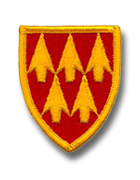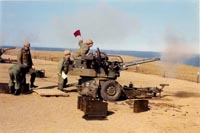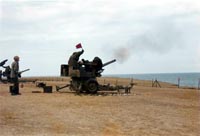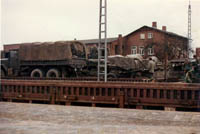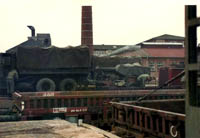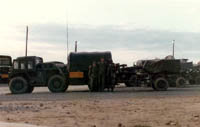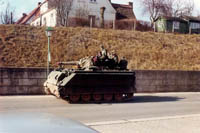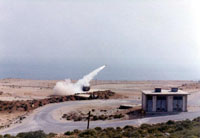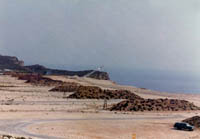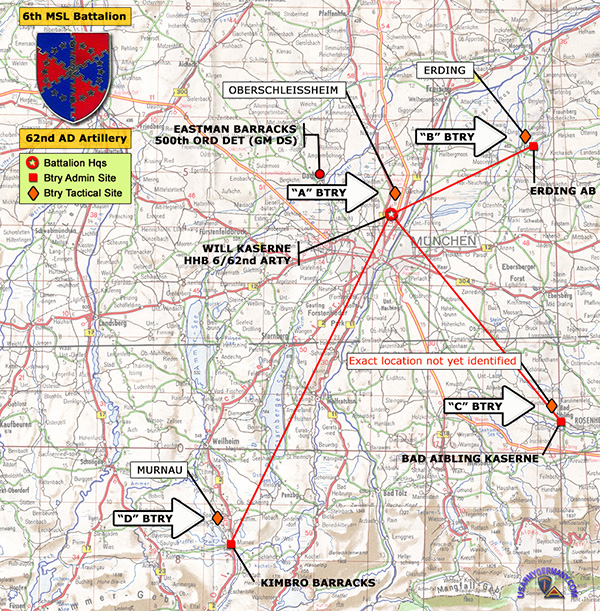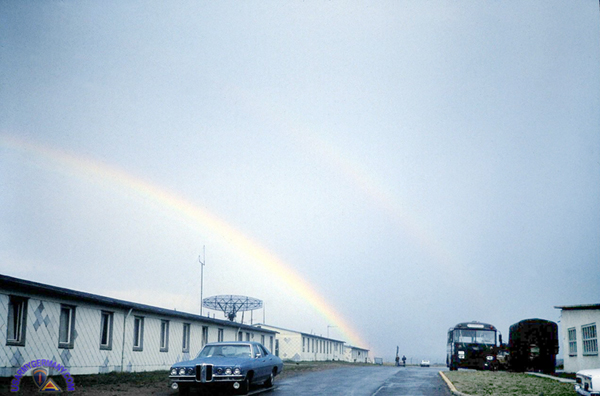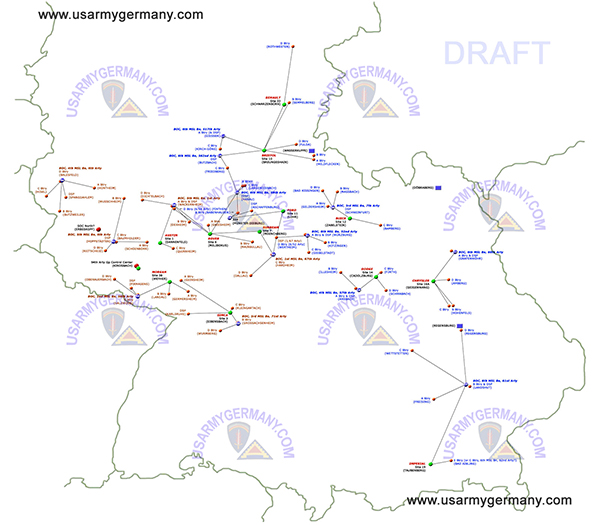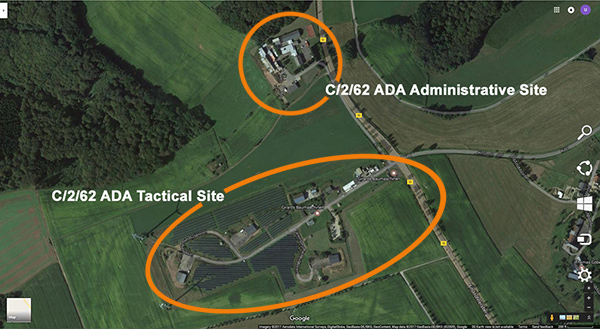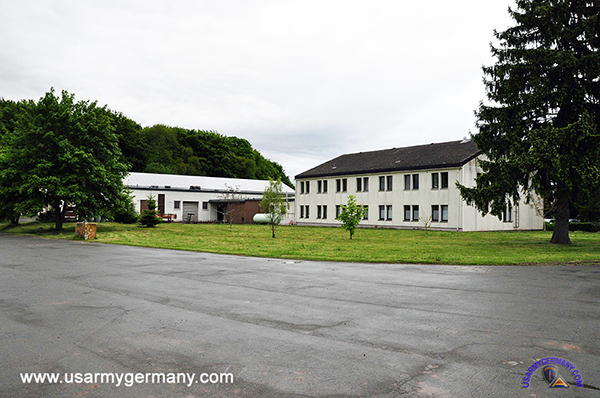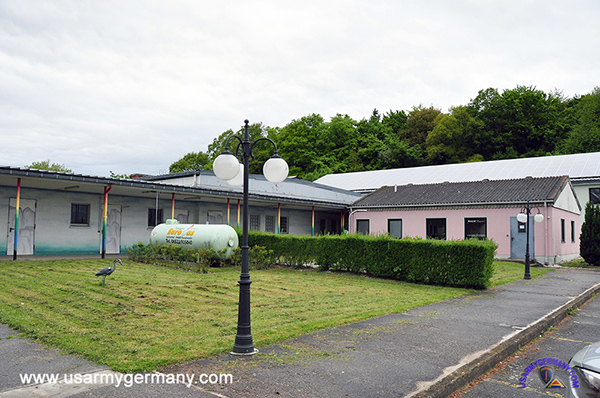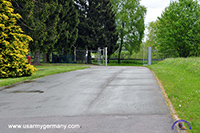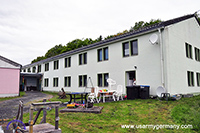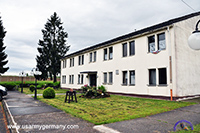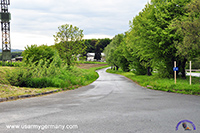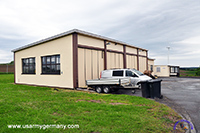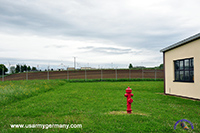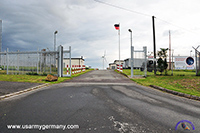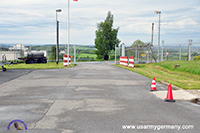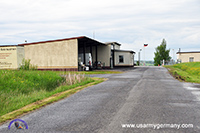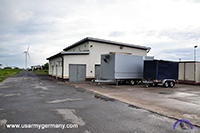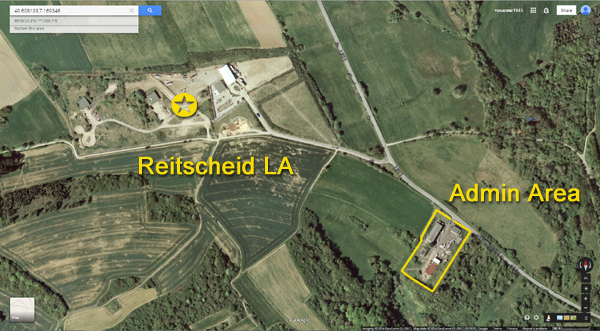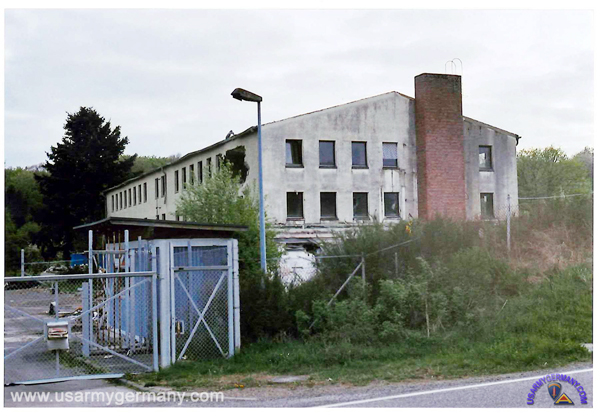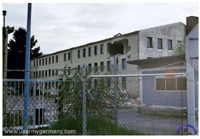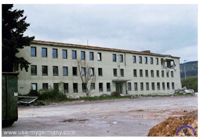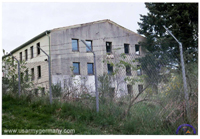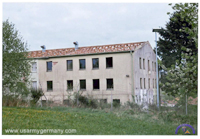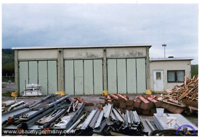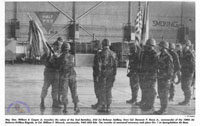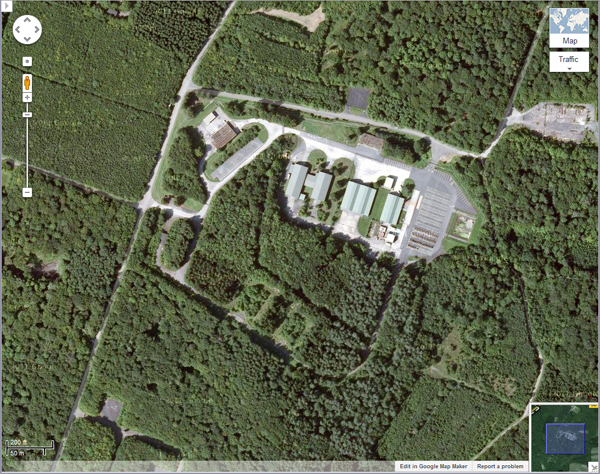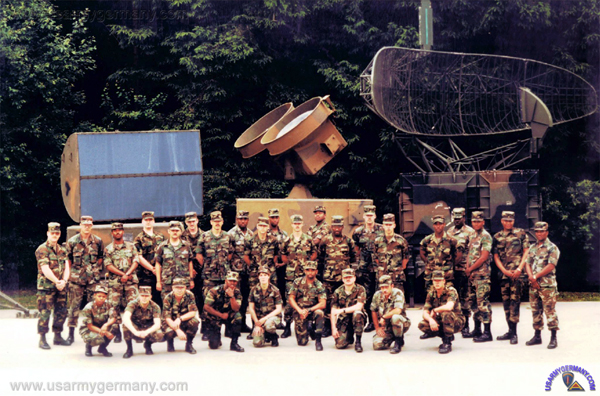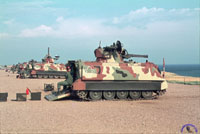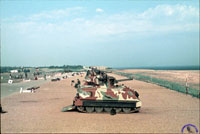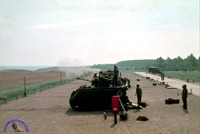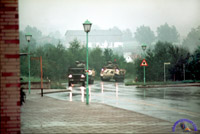| If you do
NOT see the Table of Contents frame to the left of this page, then
Click here to open 'USArmyGermany' frameset |
||||||||||||||||||||||||||||||
|
108th
Air Defense Artillery Brigade |
||||||||||||||||||||||||||||||
|
|
||||||||||||||||||||||||||||||
|
||||||||||||||||||||||||||||||
|
|
||||||||||||||||||||||||||||||
| History | ||||||||||||||||||||||||||||||
| 1974 - 1992 | ||||||||||||||||||||||||||||||
| On 26 August
1974, the 108th Air Defense Artillery Group was reactivated at Kapaun
Barracks, Kaiserslautern, Germany, as the only Chaparral/Vulcan Group
in the US Army. The Group initially was composed of three Chaparral-Vulcan
battalions: In September 1975, the Group moved from Kapaun Barracks to Kleber Kaserne, also in Kaiserslautern. In November 1977 (1), a HAWK battalion, 2nd Bn, 62nd ADA, was added to the Group, making it the only multi-weapon Group in 32nd AADCOM. On 1 October 1982, the Group was redesignated as the 108th Air Defense Artillery Brigade. On 15 April 1992, the Brigade moved to Fort Polk, Louisiana. (1) (Source: Micheal J Runkle) In 1980, 2/62 ADA was transferred from 10th AD Gp to 108th AD Gp (see additional comments) . |
||||||||||||||||||||||||||||||
|
|
||||||||||||||||||||||||||||||
| 1974 | ||||||||||||||||||||||||||||||
| (Source: Email from Pat Riggs) | ||||||||||||||||||||||||||||||
| I was reading through the info on 6/62 ADA (also known as 2/62 ADA) and can add a couple of bits of information to that, as well as 2/67 ADA.
When I was in 32d AADCOM (1974-1977) it was comprised of 4 Groups. 10th and 69th ADA Groups were Hawk. 94th ADA Group was Nike-Hercules. 108th AD Group (not ADA, go figure…) was Chaparral/Vulcan. I believe 10th ADA Group had the more northern part of the US sector and 69th ADA Group the southern section, but I’m not 100% sure. As regards 2/67 ADA it moved from Kapaun Barracks in Kaiserslautern around 1975 or 76 to the Mannheim area in conjunction with HQ 32d AADCOM moving to Darmstadt and the Air Force taking over Kapaun Barracks. (This was all part of Exercise Creek Swap when the Air Force picked up responsibility of Kaiserslautern and the Army picked up Weisbaden – Probably the only time the Army didn’t get the short end of the stick in dealing with the Air Force regarding installations…) I think elements were stationed at Sullivan Barracks and Coleman Barracks. D Battery stayed in Germersheim with the mission of defending the Germersheim Army Depot. At some point along the way the batteries switched from being Vulcan-pure or Chaparral-pure to being a mix of each system. 2/67 ADA wore the 1st ID patch, even though they were chopped to 32d AADCOM in peacetime. In the 108th during my time there, in addition to 2/67, there was 2/60 ADA, located in Kaiserslautern, Ramstein and Pirmasens and 6/56 ADA located at Bitburg, Spangdahlem and Hahn Air Bases. Both battalions were SP Chaparral and towed Vulcans (with the long-gone but not lamented Gamma Goat…). Unit stationing, if I remember properly was: HHB 108th Air Defense Group – Kleber Kaserne, Kaiserslautern (I was S-2 from 1976-77) HHB and 92d Ordnance Detachment – Ramstein AB 6/56 ADA HHB & ??? Ordnance Detachment – Spangdahlem AB 2/67 ADA HHB & ??? Ordnance Detachment – Sullivan Barracks, Mannheim (I think) Hope this helps sort things out somewhat. Let me know if you have any questions. |
||||||||||||||||||||||||||||||
| (Source: 32nd AADCOM News, Special Orientation Issue, October 1981) | ||||||||||||||||||||||||||||||
| 'Vulcaneers'
provide low altitude defense This system is a 20mm self-propelled or towed gun for low-altitude air defense. It has a rotating 6-barrel cannon which fires at a rate of 1,000-3,000 rounds per minute against air or ground targets. In addition to low flying aircraft, the Vulcan can be used against stationary or moving targets such as personnel, trucks, and light weight armored vehicles. The self-propelled Vulcan is highly mobile, capable of high-speed operations on improved roads, cross-country travel over rough terrain, and amphibious operation on streams and small lakes. The towed Vulcan has essentially the same target engagement capability as the self-propelled Vulcan; the primary difference is that the towed Vulcan uses a linked feed system and is mounted on a trailer. The system is designed to be towed by a 1½-ton truck; however, an adapter permits the system to also be towed by a 2½-ton truck. Chaparral AD system adds tracked mobility to 108th Group team. This missile system provides protection against low-flying rotary wing, propeller-driven, and high-speed jet aircraft. It is employed to provide air defense of the division, theater and Army service area, and selected airbases and installations. It is used in conjunction with the Vulcan air defense gun and is mounted on the light-weight, full-tracked vehicle which gives it mobility across lakes and streams, extended cross-country travel over rough terrain, and high-speed operation on improved roads and highways. It is a surface-to-air, infrared homing missile. Effective employment of the system depends upon visual target detection, tracking and recognition. The system is air portable by cargo aircraft. The launching station may be sling-lifted by helicopter when separated from the carrier. The system is composed of three major elements: the launching station, carrier, and the missiles themselves. |
||||||||||||||||||||||||||||||
| (Source: Email from Pat Riggs, C Btry, 2/60th ADA and HQ 108th AD Gp, 1974-77) | ||||||||||||||||||||||||||||||
| I was assigned to the 108th AD Group from 1974-77. This was an "Air
Defense" Group and not an "Air Defense Artillery" Group. Along with the
10th (Hawk), 69th (Hawk) and 94th (Nike Hercules) and 11th Sig Bn, they made up the 32d AADCOM. From 1974-75 I was a Platoon Leader in C Battery, 2/60 ADA. We were a towed Vulcan (using Gama Goats) and SP Chaparral unit. Location was Daenner Kaserne in Kaiserslautern. B Battery and the Battalion HQ was at Ramstein AB, along with our organic Ordnance Detachment. A Battery was at Husterhoeh Kaserne, Pirmasens. C Battery's mission was to defend Kaiserslautern Army Depot and the eastern approaches to Ramstein AB. B Battery defended Ramstein. A Battery had Zweibrücken AB. When I arrived then LTC Jim Cercy had just taken over the Battalion. The C Battery Commander was CPT Morris Wood. I served as a Platoon Leader for about 18 months and then moved over to the 108th Group HQ as the S-2. I was the second S-2 in the Group, following a CPT McDaniel. My NCOIC was SSG Herb McArthur and he kept his inexperienced boss out of trouble most of the time. The 108th was made up of the 2/60th ADA, 6/56th ADA (at Bitburg, Hahn and Spangdahlem) and 2/67th ADA (Mannheim and Germersheim). 2/67 was different as it was a 1st ID REFORGER unit and had SP Vulcans. 2/60 and 6/56 had towed Vulcans. I spent a lot of time on the road conducting security inspections on the units in the 108th. Not much intelligence work, but a lot of Physical Security. I new AR 190-11, as well as the USAREUR and 32d AADCOM supplements like the back of my hand. There was a huge emphasis on physical security due to the Baader-Meinhof and Red Army Faction attacks on USAREUR elements shortly before I arrived in country in 1974. I also ran the Chaparral Annual Service Practice (ASP) at the NATO Missile Firing Installation (NAMFI) in Crete in 1976 and 1977. It was tough duty, briefing the incoming units on Sunday, firing on Monday and then nothing for the rest of the week. Got plenty of time to explore Crete and took advantage of it. |
||||||||||||||||||||||||||||||
| (Source: Email from Allan Hill) | ||||||||||||||||||||||||||||||
| I was the Shop Officer for the 92d Ordnance Detachment in Ramstein from 1979-1981, and Commander of the 224th Ordnance Detachment in Spangdahlem from 1981-1982. The 2/60 ADA Bn missions were to defend Ramstein, Zweibrucken, and Sembach AB’s. During the Iran Hostage Crisis, we had a contingency mission to set up in the Straits of Hormuz. We had at least 1 battery on alert to do so. I was duty officer the night the hostages were released. We didn’t get the order to stand down until they were safely back in our hands. Here are some missing links to your 108th ADA Bde units: 6/56 ADA Bn You are correct that 6/56 had batteries at Spang (A Btry), Bitburg (B Btry), and Hahn (C Btry). Since the mission was to defend air bases, it made sense to be stationed there. 2/67 ADA Bn Located in Mannheim. 2/67 had Self-Propelled Vulcans, since they were a divisional unit, forward deployed. They were attached to 108th ADA Bde in peacetime. Col. James Cearcy was the Bde Cdr when I was there. I believe he retired as a 2 star. I remember he was a chain smoker, but aced the PT test for an 18 year old. Lt. Col. Donald Lionetti was my Bn Commander when I was in the 2/60 ADA Bn. He retired as a 3-star. I was in the 3rd Cav Regiment at Fort Bliss when Lionetti was the ADA School Commandant (2 –star) and he still remembered me. He then worked for Lockheed Martin on the MEADS program and has since retired. Good man. Lionetti was followed by Col. Dominic Rocco. The 108th ADA Bde was deactivated when they pulled the C/V units out of Germany. It was reactivated a few years ago and now provides ADA support to the XVIII Airborne Corps. My nephew is an Avenger gunner. He deployed to Afghanistan wearing an 82d Abn Div patch, and returned wearing a 108th ADA Bde patch. I don’t remember a 108th ADA patch when I was in Germany. We all wore 32d AADCOM patches. My nephew is now an E-5 at Fort Campbell. I hope this info helps flesh out some of the missing information on your site. |
||||||||||||||||||||||||||||||
| (Source: The AIR DEFENDER, September 1988) 108th ADA Bde is a composite brigade: |
||||||||||||||||||||||||||||||
|
|
||||||||||||||||||||||||||||||
| 108th Group AADCP | ||||||||||||||||||||||||||||||
| 2nd Bn, 60th ADA | ||||||||||||||||||||||||||||||
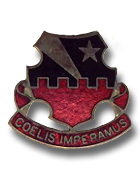 2nd Bn, 60th ADA DUI 2nd Bn, 60th ADA DUI |
||||||||||||||||||||||||||||||
| (Source: Email from Willie Sass, A Battery, 2nd Bn, 60th ADA, 1972-74) | ||||||||||||||||||||||||||||||
|
||||||||||||||||||||||||||||||
| 7th Bn, 61st ADA / 6th Bn, 56th ADA / 5th Bn, 44th ADA | ||||||||||||||||||||||||||||||
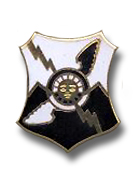 7th Bn, 61st ADA DI 7th Bn, 61st ADA DI 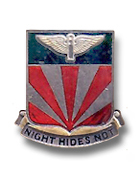 6th Bn, 56th ADA DI 6th Bn, 56th ADA DI |
||||||||||||||||||||||||||||||
| (Source: Email from Wendell Welch) | ||||||||||||||||||||||||||||||
Surfing the web and ran across this sight on the 32nd. I was stationed in Spangdahlem in 1971-1973, 7th BN 61st ADA but was changed to the 6th BN 56th ADA before I returned stateside in Feb 1973.
Do not remember a whole lot, few plane crashes at Spangdahlem during that period. I guess the biggest event was the Olympics were at Munich and some of the athletes were killed by terrorist. I remember the "Black September" group kept us on alert a lot. Had to be real careful off of base and those of us that had family living there had to be careful of where we went. For the most part Germany was good duty and enjoyable. I do remember that when I first got there the money exchange was 4 marks to a dollar but was less than 3 when I left. We went to Todendorf to fire the "Vulcans" and Crete to fire the Chaparrals. I was in "A" battery. My First sergeant was from El Paso, Lucas T. Selby, and Capt. was C. T. Stowers. Seems like I remember a Colonel Muncy also. |
||||||||||||||||||||||||||||||
| (Source: Email from Michael P. Sebek) | ||||||||||||||||||||||||||||||
| I just stumbled across your page on the 32d AADCOM at: http://www.usarmygermany.com/ and I just wanted to pass along some info. After completing Chaparral AIT at Fort Bliss, TX in November 1971, I was assigned to Hq and Hq Btry, 7th Battalion, 61st Air Defense Artillery on 5 January 1972. While there, I was retrained as the battalion legal clerk, and worked in the S-1/Admin Section from Jan 1972 through Jun 1974. The 7/61 was termed a "separate" battalion, as it had no group affiliation when I first arrived and the battalion commander held his own Special Court-Martial jurisdiction. Sometime in late 1972 or early 1973, we reflagged as the 6th Bn, 56th ADA. At that time, the 6/56 gained a group affiliation (108th ADA Group) but due to distance from 32d AADCOM HQ in Kaiserslautern, our commander retained his own Special Court-Martial jurisdiction. During this entire period for both 7/61 and 6/56, our HQ element, the Hq and Hq Btry, and the A Btry were located at Spangdahlem Air Base. Our B Battery was at Bitburg Air Base, and our C Battery was at Hahn Air Base. We had an ordnance element - the 224th Ordnance Detachment - which was also located in the Bitburg area. We also had a sister unit - a Hawk missile battalion designated as the 2d Bn, 62d ADA - which was also headquartered at Spangdahlem Air Base. I don't recall the specific location of 2/62's batteries. but the HQ was at Spangdahlem. |
||||||||||||||||||||||||||||||
| 5th Bn, 44th ADA (6/56th reflagged as 5/44th ADA under Army Regimental System) | ||||||||||||||||||||||||||||||
| (Source: Email from Brad Bishop) | ||||||||||||||||||||||||||||||
| Just got a look at your web site while looking for info on a past unit I was assigned to (6/56 ADA). Wanted to pass on the following info since it would seem a little more current than other info I saw folks had contributed. Hope it's helpful. I'm retired from the Army, but still work as a contractor supporting Air Defense here at FT Bliss TX. I'll pass your site on to numerous folks here who may want to add their bits and pieces of recollections of time spent in FRG. Anyways, here's my two cents......
I was a BN Staff Officer/Battery Commander assigned to 6/56 ADA from 1985-89 at Spangdahlem and Bitburg Airbases in Germany. Arrived in early 1985 to be assigned to BN staff after having completed the ADA Officers Advanced Course at FT Bliss. Served about a year as an Ass't BN S-3 Officer and then a year as the BN S-1. I then was assigned as Battery Commander to B Btry in Bitburg. The BN Commander upon my arrival was LTC Dan Montgomery, whose tenure ended shortly after my assignment as Battery Commander. His successor, LTC Chip Fackner, was my boss until I was reassigned stateside in 1989. During his tenure, the BN was reflagged as 5th Bn, 44th ADA. We were assigned under 108th ADA BDE out of K-Town. BDE Cdr's while I was there were COL Jay Garner, COL Larry Butterworth and COL ?. Point of interest is that Chip Fackner had been a young Captain in this BN a few years earlier and had commanded B Btry at Bitburg, during the "bad old" days directly following the Vietnam War. Our mission was Air Base Air Defense for Spangdahlem Air Base (A Battery & HHB), Bitburg Air Base (B Battery) and Hahn Air Base (C Battery). "Spang" Air Base had the Wild Weasel mission for USAFE and flew F4's and was just getting in F16's to supplement the F4's. Bitburg had an air superiority mission with their F15's and Hahn had a mixed missions with just F16's. Our Battalion had the line Batteries organized with 2 Platoons of Chaparrals, 2 Platoons of towed Vulcans and 1 Stinger "Section" mounted in M151's. Each platoon had 4 weapon systems, or squads, and the Stinger section had 5 two man Stinger Teams. The HHB had the FAAR Platoon as well as the normal staff support elements. Each Battery had a barracks located on their Air Base as well as a Tactical Site (Tac Site) where motor pool, maintenance shops and usually platoon work areas were located. At Spangdahlem, the Tac Site was located on the Air Base but for Hahn and Bitburg the Tac Site was off the base on separate sites. My Tac Site at Bitburg was around 5 KM's off the base located in a heavily wooded area. All the Tac Sites were secured by double fences with concertina wire and a couple of guarded gates. The guard force was our own soldiers, supplemented by the infamous "guard geese". At Bitburg we had a separate Ammo Supply Point a few hundred meters up the road and thru the woods from our main Tac Site. We kept our missiles and 20mm ammo, as well as small arms ammo stored there. At Bitburg we had a third separate area that included the mess hall as well as the 2/62 ADA (HAWK) Battalion's maintenance company site that was down the road a little under a Km or so. Our Battalion maintenance company was co-located on the B Btry Tac Site (507th Maintenance I believe their designation was). As the tactical unit commander, I was the overall site commander, although the Maint Co commander tried their best to ignore that fact! As Btry Commander, some of the key personnel during my assignment was my First Sergeant, Randy Stephens, 1LT Jeff Underhill (Btry XO), 2LT Bill Schiffer (Chap Plt Ldr), 2LT Tony Micele (Vulcan Plt Ldr), 2LT Jay Patton (Chap Plt Ldr), CPT Kirk Lawrence (C Btry Commander), CPT Rick Stephens (A Btry Commander), CPT Joe Jezersky (HHB Commander), CSM Doctor, CPT Dennis Lumpton (S4), 1LT Kent Cusack (S2), MAJ Bill Larimore (S3), and MAJ Prouty (BN XO). During exercises and evaluations we would practice our primary mission of defending the three airbases with our tri-base interlocking defense coverages. We normally would conduct training for "off base" missions where we would convoy 30 - 100 KM's and assume secondary air defense missions. On a couple of occasions we conducted river crossing operations of the Moselle river by "swimming" the Chapparals (very exciting, especially if you were in the Chapparal as it chugged across the fast moving river!) and using an Army boat unit to raft over the rest of our equipment. We conducted twice a year aerial gunnery ranges for the Vulcans at the North Sea ranges at Putlos and Totendorf Germany as well as various ground gunnery Vulcan ranges down in the Baumholder area. For missile firings we went once a year to Crete (Nato Missile Firing Range or NAMFI) to live fire the Chaps and Stingers. We had great relationships with the Air Base commands we supported, and in fact were always getting "unofficial" admin and tactical support from them. In return we provided a lot of "unofficial" training for their Security Police personnel, who had a primary mission to fight and defend the air bases as infantry in event the balloon ever went up. Also enjoyed good relations with the local nationals, who viewed us as a serious source of primary or supplementary income. I recently went back to the Eifel area on vacation and discovered that Spang was alive and well, not to mention bigger than ever. Bitburg and Hahn had morphed to civilian airports but the military housing was still being used in Bitburg by the overflow from Spangdahlem. |
||||||||||||||||||||||||||||||
| 6th MSL Bn, 62nd Arty / 2nd Bn, 62nd ADA / 1st Bn, 1st ADA | ||||||||||||||||||||||||||||||
|
||||||||||||||||||||||||||||||
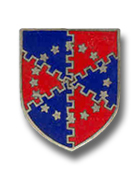 2nd Bn, 62nd ADA DUI 2nd Bn, 62nd ADA DUI |
||||||||||||||||||||||||||||||
| 1964 | ||||||||||||||||||||||||||||||
| (Source: Email from Robert B. Greenberg) | ||||||||||||||||||||||||||||||
| Just happened to be looking at the web and telling "war stories" to my youngest son who is on active duty and thought I would see if there is any thing about my old unit the 6/62nd. I was a communications center specialist at HQ Btry 6/62 stationed at Will Kaserne in Munich. Arrived at Will in May 1964. The 62nd then moved from Munich to Ashaffenburg about a year later. Should know how to spell A-burg after typing hundreds of TWX's. Have many fond memories of my time with the 62nd both in Munich and A-burg. Left active duty in 1966 to go to school on the GI Bill, but continued doing the military thing retiring from the Air Guard with 30 plus years of service including my time with the 6/62nd. Recently moved to Florida. |
||||||||||||||||||||||||||||||
| 1965 | ||||||||||||||||||||||||||||||
| (Source: Email from Anthony Cantanucci, B Btry, 6th Bn, 62nd Arty) | ||||||||||||||||||||||||||||||
| I'm looking for more info on my unit which was B Battery 6th Battalion 62nd Artillery (Hawk). I was stationed in Aschaffenburg, Germany, Jaeger Ksn.,
B Battery in Headquarters building, from late 1965 till my discharge in May 1967. I was classified as 16D20 Hawk Msl. Crewman and at the time of my honorable discharge I was crew chief Specialist 5 Anthony Cantanucci. Our tac site was located in Darmstadt, Germany. We were part of the 32nd Army Air Defense Command. According to the history stated, it claims we were in Dachau during the 60's. Recently I have been trying to track down some of my Army buddies and I was trying to locate 32nd AADCOM pin, red & yellow with five arrowheads, I have patches but would like to add the pin if such a thing exists. |
||||||||||||||||||||||||||||||
| (Source: Email from Medrick R. Northrop) | ||||||||||||||||||||||||||||||
| I enjoyed going over the site. I was a 16E, TCA for D Battery, 6th Bn. 62nd Arty, at the E. Ludwig Kaserne in Darmstadt. Our HAWK site was at a small airfield across the river above Wiesbaden. We worked 24 on 24 off. Was there for most of 3 years, November 1965 - Oct. 1 1968. Actually drove by the Kaserne in 1992 as I was with the 640th Ordnance, Alabama National Guard, downloading ammo to rail yards after coming back from Desert Storm. As a result, still have contact with several other guys that were in the Battery with me, and the brother of a young lady from England I met at a ski school, came to Alabama and was best man at my wedding in 1969. He later moved to Chicago, we still get together once a year or so…. good memories. I have seen the Kaserne on-line and showed my wife the window of my room, mess hall and rod and gun club (also had a small bar). I still have, and shoot, a rifle (Husqvarna) and Remington shotgun I bought there, I have many, but I still actually use these as I hunt a lot and shoot trap/skeet. Every time I pick them up I remember those times. I tried to find the tac site outside Wiesbaden several times on Google Earth. It was at a small airfield surrounded by cherry orchards, the locals used a strip near the site to use gliders on. The gliders were cabled to a chevy engine they got from somewhere. I think I found it once but appears now to be a subdivision. Have a few pictures from there, but do not show much but up-close stuff, me, radar, old trailer living quarters etc. I’ll try again shortly. We were told the old bombed out home/mansion nearby (200 yds) and airfield, was Herman Goerings private field. Don’t know that to be fact, but one could tell the home was quite a structure at one time. As I remember, Bldg. 4232 had the rod and gun club sales and small bar upstairs. 4233 was our mess hall, down stairs. 4234 was D battery barracks - all floors as I remember. Supply and arms room down stairs/basement. Coal fired heat with the coal piles located behind our building. 4246 had a library and gym, and I believe 4236 was the officers club, could have been next smaller bldg down, but don’t think so. First floor of 4231 is where the gate guards reported as I remember. Flag pole is of course where guard mount was held. I have a picture someplace of 6th Bn parading in the compound, change of command ceremony of some sort, 32 ADCOM had a name change around that time I think also. I’ll have to think some more as to what other units were in the compound with us. There was a firing range nearby, I used to take my personal weapons there often, but don’t remember where it was in relationship to the kaserne. Hope this helps some. Can anyone identify the exact location of the "D" Battery tactical site? |
||||||||||||||||||||||||||||||
| ADDITIONAL INFORMATION Webmaster note: In reviewing the USAREUR Station List from 30 June 1965, it would appear that there was a permanent change of station for 6th Bn, 62nd Arty in mid-1965. Battalion headquarters and most of the firing batteries were moved to the Aschaffenburg-Damrstadt area - this is probably because the battalion's tactical sites in the Munich-Murnau area were taken over by a French HAWK outfit in that timeframe. The Station Lists states the following deployment (1): |
||||||||||||||||||||||||||||||
|
||||||||||||||||||||||||||||||
| (1) The relocations to the new stations was supposed to be effective 1 August, 1965. (2) Battery did not move. It was possibly redesignated and assigned to a different HAWK unit. |
||||||||||||||||||||||||||||||
| 1972 | ||||||||||||||||||||||||||||||
| (Source: Email from Sam Bass, Sr.) | ||||||||||||||||||||||||||||||
July 04 1972 - I was an Sp4 16D and was sent Germany. I was sent first to the 21st Replacement (battalion) for a week and then assigned to
C Btry 2/62 in Hisel. The sites were all transformed from NIKE sites to HAWK. |
||||||||||||||||||||||||||||||
| (Source: Email from John Welch) | ||||||||||||||||||||||||||||||
| I want to congratulate you for the work that goes into keeping the history of USAREUR alive. It is remarkable to think about the national resources it required to protect freedom and eventual defeat the Soviet Union through a commitment to readiness ($) that they eventually could not match. My early days in the Signal Corps were as a young officer in 32d Army Air Defense Command. I was a history major in college but the Army in their way of doing things decided I would be a Signal Officer. It served me well for 27 years where a career was capped off with both battalion and brigade command before my retirement in 1998. My first assignment was as the signal officer for the 6th Battalion, 62nd Air Defense Artillery (Hawk) with a headquarters at Spangdahlem AFB and the Battalion Control Center located about 20 miles north of Bitburg at Balesfeld. I arrived in Feb 1972 and was a brand new second lieutenant that was being assigned to a captain's position as both the battalion signal officer and in fact what amounted to being the platoon leader for the highly disperse signal soldiers operating the multichannel radio relay equipment at the the BOC and the four firing batterys. USAREUR was still much in the shadow of Vietnam at this time, there were no facility renovation programs, drugs were an issue, race relations were not good and USAREUR was at a low ebb. It was a challenge. I was in the 6/62d ADA (later redesignated 2nd Battalion, 62nd ADA in late 1972 or during 1973. I learned so much but without a senior NCO to support my most critical responsibility of the ensuring the reliability of the multichannel radio relay systems in the Battalion and our shot to the Missile Control Center at Erbeskopf, it wore me down. I did pursue and gain a reassignment in January 1974 to the Headquarters of the 11th Air Defense Signal Battalion at Kapaun Barracks in Kaiserslautern. I became the SYSCON Officer for the battalion for the next 19 months. The Battalion SYSCON, as all the veterans of the battalion well understood, maintain the status of all radio systems as reported from the designated control terminal within each of the line companies. It was me that had my SYSCOM operators constantly calling to get more and better information during radio system outages because I was the guy that stood before the battalion commander in the morning to explain every outage and every detail. I was frequency armed with less than defining reasons as "bad wiring". I knew bad wiring was a defense mechanism when the site did not know what caused a system to come back on line but had to contort the all dreaded Reason for Outage or be required to provide a detail outage to report to explain what they could not explain in the first place. The good news was that the "bad wiring" RFO was not uncommon but generally reasonable explanations were given. It was a leadership lesson for me that it was my job to take the butt chewing from the battalion commander for not getting better information and a subsequent butt chewing from a company commander requiring detailed outage reports. I left the battalion in July 1975 to return to schooling at Fort Gordon and subsequently a multi-service telecommunication staff officer course at Keesler AiFB, Biloxi, Ms. My wife and I missed Germany. I made a fairly bold decision to travel to Washington DC to meet with my assignment officer for a review of performance record, as officers are encouraged to do. My other agenda was to have some face to face contact and ask to go back to Germany. I was successful as he put me on orders to USAREUR. I wanted to compete for company command as a fairly new captain and wrote to the 11th Signal Battalion XO, who was still in the unit from my time in the unit and knew me well, to tell him I was being put on orders to USAREUR and would like a chance at competing for a command in the 11th Signal. Things moved very quickly as he called MILPERCEN-Eur (later redesignated as 1st PERSCOM) to get me assigned to 32d ADDCOM and then directly into command of B Company, 11th AD Signal Battalion in Wurzburg. I was elated but let me turn away from the career of John Welch and comment on a few things that I can provided comment upon from my time. |
||||||||||||||||||||||||||||||
| The radio system map presented on the 11th Signal Site was very good and reflected history as I heard it in early 1970s as to how things had evolved from the the mid-60s. There was important transition in 32D ADDCOM in the 1970 time frame as the need was seen to bring some air defense coverage back from the border facing East Germany to augment the Air Force fighter bases west of the Rhein (Ramstein, Zweibruckeh, Hahn, Bitburg, and Spangdahlem). There were support to be two Hawk battalions that came west but eventually only the 6th Battalion 62D Air Defense Artillery made the move in 1970 to Spangdhalem with firing batterys providing overwatch for the fighter bases. There was also the addition of Chaparral-Vulcan units that beefed up the very close range support for the several airbases. This means that systems reaching down towards Munich and Bad Aibling were taken out when 6/62d ADA moved West. The radio system diagram from the mid-1960s did not reflect systems to connect the Battalion Operations Centers to a missile control facility for integrated engagement among the several battalions. There is probably no indication of a system going higher from battalion because this was probably done with leased lines from the Bundespost. Unlike the Hawk units, the high priority of security matters in the nuclear equipment Nike-Hurcules Battalion gave them the benefit of Bundespost landlines that went all the way down the Nike firing battery. There was a bit of a morale problem in the signal section of these Nike Battalions because the tendency was solely to use the land line communication and not the more temperamental radio systems. It really made the MOS 31M personnel in these units a bit frustrated and wondering why they were working significant hours around the clock if their talents were not being used. The answer is, as the Nike Units got closer to their annual NATO tactical evaluation, there was a big rush in these units to train with the radio systems because it would be required during the TacEval. I hope you are still out there covering down on this great effort of capturing the history of USAREUR. I grew up in USAREUR as a family member in Frankfurt, Baumholder, and Herzo Base before returning home in 1972 to 32d AADCOM. I will return later to talk more of the signal sites and fill in some pieces for the 1972-1979 period.) |
||||||||||||||||||||||||||||||
| 1973 | ||||||||||||||||||||||||||||||
| (Source: Email from Francisco A. Siaca) | ||||||||||||||||||||||||||||||
| I read the comments by Sgt. Sam Bass, who I remember very well. I was stationed at C/2/62 in Hisel, Germany, from July 1973 to February 1975. I was assigned to the motor pool my entire time there. The battery had recently been upgraded to Improved Hawk before I arrived. As Sgt. Bass mentions, we received support from the Bitburg Air Base and our battalion HQ was located in Spangdahlem, @30km from the battery. The location of the battery was relatively isolated and we maintained our own mini-PX and had a visiting barber. There was no public transportation from the battery to downtown Bitburg, so the battery operated a “shuttle” 2 ½ ton truck to Bitburg at 6:00 pm and a pickup “shuttle” in Bitburg at 12 midnight. The CQ runner normally drove the truck. I went back to Hisel in 2013 and took several photos of the former battery, which is no longer there. The barracks and admin area have been converted to low-income housing and the TAC site is now operated by a solar power/windmill turbine company. Nonetheless, all of the original building in the TAC site and admin area are still there. I am including several photos that I took of the battery area during my visit. |
||||||||||||||||||||||||||||||
|
||||||||||||||||||||||||||||||
| 1978 | ||||||||||||||||||||||||||||||
| (Source: Email from Randy Bachmeyer, B Btry, 2/62nd ADA) | ||||||||||||||||||||||||||||||
I was an MP stationed in Butzweiler, Germany from 1978 thru 1990. Butzweiler is a small village about 25 km south of Bitburg which hosted a Nike Ajax ADA site which later became a Nike Hercules ADA site. The designations of the units and when they existed as such are not known by me.
When I arrived in 1978, the site had already been converted to B Battery 2/62 ADA (HAWK), and was part of the 10th ADA Brigade. 2/62 ADA was Headquartered in Spangdahlem Air Base, and the four ADA Batteries A, B, C, D, and the support element were deployed around Bitburg and Spangdahlem. The mission was part of the over all air defense of the Eifel region including Bitburg, Spangdahlem, and Hahn Air Bases, and a few German Air Bases in the region. 2/62 ADA was redesignated as 1/1 ADA (I believe) around 1985 (the exact year I can no longer recall) and became part of the 108th ADA Group (and later redesignated ADA Brigade). I was responsible for the over all physical security of B Battery as an MP sergeant, and NCOIC of a 10-man MP section within the Battery. My greatest challenge during the 1980's was to protect the Battery from terrorist threats from groups like the Baader-Meinhof gang and the Red Army Fraction. In or around 1988 one of these groups managed to enter one of our sister HAWK Battalion sites in the Baumholder area, and planted two bombs which effectively destroyed two radar units. It was later conveyed to me after the fall of the Berlin Wall 1989, that East Germany had been harboring some of these terrorists. Intelligence discovered a home in the former East Germany that contained evidence of having housed some of these people. B Battery 1/1 ADA (to which I had been assigned), had been surveilled by these terrorists before the bombing. Notes that were discovered to have been made by the terrorists indicated that security at the B Battery 1/1 ADA site posed too great a risk to the terrorists and they chose an easier target. I was especially proud to have heard that. ADDITIONAL INFORMATION Nike Herc units had a small platoon of MPs assigned to each Battery for security of the warheads. They manned the access control points and the guard towers at those sites. To the best of my knowledge all HAWK Batteries had only 12 MP's organically assigned as TO&E for physical security at their base stations, and we performed ground defense in their deployed positions. No one could ever tell me why there were only twelve of us. Twelve alone were not enough for ground defense, but I'm sure in the over-all grand scheme, there must have been other plans beyond my need-to-know. We had no authority at the Battery as far as law enforcement. We were just part of the over-all 150 man strong unit, and our job was just physical security.
An MP who I was stationed with after I left HAWK stated he had been assigned to a HAWK Battery in Key West Florida, so to answer your question about MPs being USAREUR specific TO&E, I guess it was Army-wide. The HHB's had no MP's assigned except for the S-2 NCO.
2/62 Bn HAWK, when I arrived in 1978, had Batteries in:
The support/maintenance element as part of the HHB was in Oberweis, west of Bitburg (on a site which once was a Bitburg Air Base Air Force Missile unit in the 1950's) After 2/62 ADA was redesignated 1/1 ADA in the early 80's, D Btry was moved to Hontheim (
I now recall that the HAWK Battery that was bombed in the late 80's was at our former D Battery site in Reitscheid, which by the time of the incident had been long redesignated as 4/1 ADA.
As an aside to all this, I became RSOP (Reconnaissance, Selection, and Occupation of Position) NCO and OIC in one. Before any deployment, there was of course a recon force that would deploy ahead of the Battery to select and secure a suitable site. This involved, among a host of other things, deploying the MPs in a ground defense role, and then "laying out" (measuring) the site to deploy the Radars and Launchers. This was normally done by an ADA lieutenant and NCO and a team consisting of the MPs, NBC specialist, power generation specialist, commo specialist, etc. Eventually, after I had been there for so long, (12 years altogether) and watching and assisting the RSOP lieutenant and NCO, the Battery Commander put me in charge of the whole mission every time we had a field exercise. When it came time for our bi-annual NATO Tactical Evaluation, the other NATO country member evaluators were in disbelief that a "mere MP" could proficiently carry out the mission normally done by an ADA officer. I received one of my very first Achievement medals for an "Excellent" rating for the RSOP during an AAFCE (Allied Air Forces Central Europe) Tactical Evaluation. Another one of my proud moments in my career.
Eventually, the MP Section also carried out the task of Stinger missile gunners for our Battery. I was also lucky enough to be chosen to live-fire one in Crete, Greece at the NAMFI (Nato Missile Firing Installation) range. (Another Achievement medal)
This was until the new MOS 16S, Stinger Crewman, was fully deployed throughout the Army.
At B Battery, we always said MP stood for "multi purpose".
ADDITIONAL INFORMATION After reviewing some of my old military awards records, I have documentation to indicate that 2/62 ADA was still part of the 10th ADA Group in 29 May 1979 and in 12 November 1985, and had been re-assigned to 108th ADA Brigade between 12 November 1985 and 17 June 1986.
I can also say for certain that some time between 17 June 1986 and 01 December 1986, 2/62 ADA, 108th ADA Brigade had been re-designated as 1st Bn,1st ADA, 108th ADA Brigade and remained so until complete deactivation in of the Battalion 1991.
I'm somewhat confused about the information you have posted about the patches worn by 108th Brigade. We all wore the 32nd AADCOM patch from my arrival to B 2/62 in November 1978 until I left B 1/1 in August 1990. You indicate it was worn from 1974 thru 1982 until another patch was worn from 1982 until 1992.
Also, I was informed that the symbolism of the 32nd AADCOM patch (for promotion board and soldier of the month board questions) was: 1. The color red was the color of Artillery.
2. The symbols on the patch represent missiles.
3. There is one row of 3, and a second row of 2 to represent the "32"nd AADCOM.
4. At the time, there were 5 ADA systems (Nike, HAWK, Chaparral, and Vulcan) in 32nd AADCOM, hence the 5 missiles on the patch.
Whether or not this information is correct is unknown by me, but it seemed to have applied. Maybe someone else can add to or verify this information. (Some of us at B Battery jokingly called the patch "The 5th Forestry Division" because the missiles on the patch looked like 5 pine trees).
|
||||||||||||||||||||||||||||||
| (Source: Saarbrückener Zeitung, March 19, 2014) | ||||||||||||||||||||||||||||||
| A March 2014 report in the Saarbrückener Zeitung (online) reported that the last buildings in the former Reitscheid Admin Area that used to house US troops serving at the nearby NIKE LA and later HAWK tactical site was in the process of being torn down. The property was returned to the German government in 1992 and initially used by a commercial business and also a refugee center. Future plans call for reverting the property back to pasture land to be used by local farmers for grazing. |
||||||||||||||||||||||||||||||
|
||||||||||||||||||||||||||||||
| 1982 | ||||||||||||||||||||||||||||||
| (Source: The News, October 1982) | ||||||||||||||||||||||||||||||
| (The 94th ) . . . and receives another one the next day By Dennis M. Utz The 2d Battalion, 62d Air Defense Artillery entered a new era in its long, proud history Oct. 1 as it began its formal change of organization and activation of its Direct Support Battery. Special guests at the 10:30 a.m. ceremony included Maj. Gen. Wiliam E. Cooper, Jr. commanding general, 32d AADCOM; Col. Paul Chase, Commander of the 52d Tactical Fighter Wing here; Col. Howard Carroll, Base Commander of Spangdahlem AB; Col. Clifton Clarke, the Vice Commander of the 36th Tactical Fighter Wing at Bitburg AB; and several other Air Force and Army dignitaries. |
||||||||||||||||||||||||||||||
|
||||||||||||||||||||||||||||||
|
Farewell remarks from Rocco capped the past year's successes of the battalion - from administration to security operations. "I have never had to transfer a command and it is an extremely sad and emotional time for me," said Rocco. He then wished the battalion continued success and "Godspeed" as it became a member of the 94th ADA Bde. Winzurk then welcomed the battalion to his brigade. "Keep headed in the direction you are headed, but never lose sight of the fact that you must `take care of the soldiers,"' he said. The ceremony was concluded with the Army song and was followed by a reception in the Spangdahlem Officers' Open Mess. The 2/62 ADA was originally organized in the Regular Army as Captain George Peter's Company, Regiment of the Light Artillery. The unit has been deactivated, activated and redesignated many times. The 2/62 has participated in campaigns from the War of 1812 through the Korean Confict, earning 41 campaign streamers, one Presidential (Navy) unit citation and four Korean Presidential Unit Citations. The unit, last stationed in Bavaria as the 6th Battalion, 62d Air Defense Artillery, moved to its present location on Spangdahlem AB in September, 1972. On Nov. 14, 1972, the battalion became NATO's first operational IHAWK battalion. In May 1980, the unit became the IHAWK (PIP) battalion it is today. Its mission is to provide low to medium latitude air defense for NATO forces in the rear area. HHB is located on Spangdahlem AB, while the four firing batteries, the Battalion Operations Center and the Direct Support Battery are at dispersed locations. In June 1981, the battalion became a member of the 108th ADA Bde and immediately applied itself to the ideals of the 108th ADA motto "Deeds above words." The battalion has completed two recent Allied Air Forces Central Europe Tactical Evaluations and several Annual service Practice firings at the NATO Missile Firing Installation range in Crete, where the Battery D fring set a five year record score of 99.15 percent. The battalion has also completed two Annual General Inspections, one of which was a USAREUR inspection. There were also many higher headquarters inspections and special visits from military dignitaries which gave the battalion a chance to "show its stuff." |
||||||||||||||||||||||||||||||
| 1983 | ||||||||||||||||||||||||||||||
| (Source: Email from Kenneth E. Love) | ||||||||||||||||||||||||||||||
| I’m writing you in ref. to E-Battery (DSB) 2/62 ADA (1983-1985) - 606th Ordnance Maintenance Company (1985-1991) under direct command of 32nd ADDCOM that I served with in West Germany from May 1983- May 1986. I’m working on putting some information together and pictures, papers etc. so to add it to our Unit’s history you have on your site. Most of I want to THANK YOU for all you have done to save this history of the Soldier’s who served in West Germany and parts of Europe during the post war and Cold War years ....It really means a lot to me to see this web site of yours and the information and History that has come together and also been saved !!!!! It was not all fun and games there and at times we had things happen around us or to us that we will remember all our lives ...We had the RAF – Red Army Fraction that did blow stuff around us and fences lines cut ,etc at some of the 2/62 ADA Tac Sites . Protestors blocking out gates at DSB in 1985 and being spit on by some of them while guarding the gate there ...I wrote a story about that day in English class essay for college ...We were there when President Reagan and Chancellor Helmut Kohl came to Bitburg on 5 May 1985 ...33 years ago and have pictures of that and the paper and badges given to us to allow entry onto the flight line with everyone there that day as Air Force 1 came in at Bitburg AB. I have sat in our Commo truck in 1983 while on Guard Duty there at the MSA lot in Oberweis with the Radio Operator keeping in contact with A, B,C, D Batteries of 2/62 ADA with one always Hot and ready to fire that went on 24/7 for decades ....But I get on the HF radio and tune to Voice of America to listen to what they had to say, only to have USSR come on and jammed VOA with their wobble noise and Radio Moscow to popup a few kcs down ...then VOA would come back on in the clear 10 or 20 kc’s back on the air ...this would go on all night ...little things you remember . We Cold War Soldier’s at many times feel forgotten and what we did accomplish there at those times forgotten also....My Heart felt Thank You and a long held Salute to you Mr. Elkins . Kenneth E. Love E-Battery (DSB) 2/62 ADA - 606th Ordnance Maintenance Company, 1983-86 Bravo Battery 1/55 ADA, 5th Infantry Division (Mech), 1986-88) |
||||||||||||||||||||||||||||||
| Webmaster Notes: Studying some of the USAREUR STATION LISTS that I have, it would appear that the 2/62nd ADA was originally attached to the 69th AAA Group - with the move to Spangdahlem Air Base in 1972 or sometime thereafter, the battalion was attached to the 10th ADA Group. It does seem that the battalion was attached to the 108th ADA Gp in 1981 and then attached to the 94th ADA Gp/Bde in 1982 when that brigade's role started to change with the phase out the the NIKE HERC missile system. |
||||||||||||||||||||||||||||||
| 1st Bn, 1st ADA (2/67th reflagged as 1/1st ADA under Army Regimental System) | ||||||||||||||||||||||||||||||
| (Source: 32d AADCOM News, February 1985) | ||||||||||||||||||||||||||||||
| Battalions swap The 2nd Bn, 60th ADA was relieved from assignment to the 108th ADA Bde on Jan 8 1985 and reassigned to the 94th ADA Bde. This move makes the 94th a truly composite ADA Bde with HAWK, C/V, Redeye and Stinger. During the same ceremony, the 2nd Bn, 62nd ADA was relieved from assignment to the 94th ADA and reassigned to the 108th ADA Bde. |
||||||||||||||||||||||||||||||
| (Source: Email from Richard "Slider" Zaiz) | ||||||||||||||||||||||||||||||
| History of the 606th Ordnance Maintenance Company (Separate), WB1KAA, Bitburg AB, Germany.
(From 1984 till 1991) In early 1982, 2/62 ADA, under the 10th ADA Brigade, sent its Hawk Maintenance section to the MSA (Missile Support Area) in Oberweis, west of Bitburg, Germany (on a site which once used by an Air Force XSSM-A-1 Matador Missile unit from Bitburg AB in the 1950's). (Note: this site was also shared with B Battery 6/56 ADA and the DSB 6/56 ADA which later became 820th Ordnance Maintenance Company (Separate). On 1 October 1982, the Hawk Maintenance section of HHB 2/62 ADA, was redesignated and activated as E-Battery/Direct Support Battery (DSB) in support of 2/62 ADA. Still operating out of the MSA in Oberweis and living in the 2/62 ADA Barracks in Spangdahlem AB. This meant traveling from Spangdahlem AB to Oberweis every day. In June 1981 (?), the US Army and 32d AADCOM decided to change (reflag) the 2/62 ADA, 10th ADA Brigade to 1/1 ADA, 108th ADA Group. On 31 May 1985, The Direct Support Battery was then to be officially deactivated. On 2 June 1985, the DSB uncased its new colors at the Old French Kasern next to Bitburg Air Base housing and was reactivate as the 606th Ordnance Maintenance Company (Separate), and assigned to Bitburg Air Base, Germany. However, the unit still worked out of the MSA in Oberweis, Germany. Now that they were a separate standalone company they did not have any Barracks and all unit personnel lived on the German economy. The unit was supposed to get the barracks in the old French Kaserne; however, the cost was too high to repair the buildings. In 1987 the unit was given the old French Kasern housing area in Bitburg and stayed there till the new Patriot Barracks were constructed on Bitburg AB. (Note: The 606th Ordnance Maintenance Company (Separate), flew the first American Flag over this French Kaserne.) The 606th Ordnance Maintenance Company (Separate), had their own unit crest and unit patch. However; the 32nd AADCOM Commander, General Roy “Pac Man” Putnam, decided all unit attached to or assigned to 32nd AADCOM will wear the 32nd AADCOM patch and unit crest. The 606th Ordnance Maintenance Company (Separate), was to be a standalone Ordnance Maintenance Company (Advance HAWK) and separate from the 1/1ADA. The 606th Ordnance Maintenance Company (Separate), was attached to the new 108th ADA Support Group, 32d AADCOM and the Baumholder Military Community. Again, however; assigned to Bitburg Air Base. Command and Control was a big issue; everyone wanted to run the unit including the Air Force. The first MTOE for the 606th Ordnance Maintenance Company (Separate), authorized a unit strength of 304 personnel and designated it as a Category 5 unit. In 1987 the MTOE was changed to show a unit strength of 140 personnel, but still a Category 5 unit. The 606th Ordnance Maintenance Company (Separate) maintain its operations on a 24/7 bases to support the 108th ADA Brigade, 32nd AADCOM, US Air Force Bitburg and NATO. In July 1986, a man and female were observed along the fence line taking pictures. When approached by our Security Guards at the main gate to the MSA they became very restless and defiant. Security Police from Bitburg Air Base came to help out the situation. The man began to fight with the security police and the woman tried to enter the patrol truck of the SP’s. She was stopped by the 606th, NCOIC of the guard force. Bitburg Polizei were called to take them away. They told the Polizei that they were from Bitburg, Germany and only on a walk. However, after the investigation; it was found out that they were from Luxembourg. In the search of their house; they found maps and plans of many of our MSA and Hawk sites. The two Security Police were immediately reassigned back to the states per Air Force policy. The Army soldiers, however remained at 606th. Seven month later they were tried in Bitburg Court and deported back to Luxembourg and placed in jail there. From 1985 till 1991 the unit had the following achievements: On a sad note, in 1988, five soldiers from the 606th Ordnance Maintenance Company (Separate) were involved in a fatal traffic accident while traveling back to Bitburg from Kassel, Germany. Only one soldier lived and remained in the unit till he PCS’ed. The accident was listed as lack of rest and falling to sleep while driving. The unit had Memorial services at the Chapel in Bitburg Housing. The 606th Ordnance Maintenance Company (Separate) had four unit Commanders, three Executive Officer (one was a Staff Sergeant) and three First Sergeant between 1984 and 1991. (Note: two commanders and one first sergeant were relieved for cause.) Between 1990 and 1991, during Operation Desert Shield and Storm, the unit was used as a filler unit for the Gulf War. In May 1991, the 606th Ordnance Maintenance Company (Separate) received the official deactivation order and cased it colors on 28 August 1991. The members of this unit were reassigned to other units in Germany and the US. On 1 Nov 1991, the MSA (Missile Support Area) Oberweis was officially turned over to the US Air Force in Bitburg.
|
||||||||||||||||||||||||||||||
| 606th Ordnance Company was Activated and Deactivated several times thoughout the years Normandy: 6-7 June 1944 Assault Landing |
||||||||||||||||||||||||||||||
| 2nd Bn, 67th ADA | ||||||||||||||||||||||||||||||
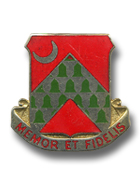 2nd Bn, 67th ADA DUI 2nd Bn, 67th ADA DUI |
||||||||||||||||||||||||||||||
| 1974 | ||||||||||||||||||||||||||||||
| (Source: Email from Richard Edwards, 2nd Bn, 67th Arty (CV)(SP)) | ||||||||||||||||||||||||||||||
| I was a 2LT with B Btry 2nd Bn, 67th ADA. The battalion was the 1st Infantry Division - Division Air Defense. A & B Battery had self-propelled Vulcans, and C & D Battery has self-propelled Chaparrals. The Vulcans went to Todendorf, Germany for annual service practice and the Chaparrals went to Crete. Headquarters Battery, and A - C Batteries were in Kaiserslautern at Kapaun Barracks, and D Battery was in Germersheim. The unit was formed at Fort Riley, Kansas, and moved to Germany in 1972. Bellow are a few pictures of B Battery firing Annual Service Practice at Todendorf. Pictures #1, 2, and 4 are from August 1974; and #3 is from April 1974. |
||||||||||||||||||||||||||||||
|
||||||||||||||||||||||||||||||
| 1975 | ||||||||||||||||||||||||||||||
| (Source: Email from Bob Keville) | ||||||||||||||||||||||||||||||
| I was reading your web page for 2/67 ADA and it is mis-located with data about 7/67. I was assigned to 2nd Bn, 67th ADA from 1 April 1975 until 14 Feb 1979 as a FAAR platoon Sgt. During that time 2/67 was part of the 1st Inf. Division. Our Bn commanders were LTC Tozier and LTC Tommy Smith. Our CSM was CSM Lavelle. Initially the FAAR platoon was stationed with D Btry in Germersheim Army Depot with A, B, C and Bn HQ in K-town. During 1976 the Bn HQ moved from K-town to Mannheim, Kaefertal/Sullivan Barracks with the FAAR platoon being attached to Bn HQ and B and C Btry’s being stationed at Coleman Barracks in Sandhofen. D Btry and A Btry stayed in Germersheim Army Depot. Our support group was the 172nd Ord Detachment stationed in Funari Barracks which is just outside of Sullivan Barracks. We were all part of 32d AADCOM/108th Group. Those were great years for me. I understand that the Bn is no longer in existence. |
||||||||||||||||||||||||||||||
| 7th Bn, 67th ADA | ||||||||||||||||||||||||||||||
 7th Bn, 67th ADA DUI 7th Bn, 67th ADA DUI |
||||||||||||||||||||||||||||||
| (Source: Email from Rich O'Connor, 7th Bn, 67th Arty (CV)(SP)) | ||||||||||||||||||||||||||||||
| The 7th Bn, 67th Arty (CV)(SP) deployed from Fort Bliss,Tx the Spring of 1970 to a former WW2 German fighter airfield in Gieblestadt. Around 1981 the 7/67 moved and and the name/number was changed. The 7th was the first air defense artillery battalion with the Chaparrel (four sidewinder missiles mounted on a track) and the Vulcan (electrically fired 20 mm gattling gun mounted on an armored personal carrier) to be formed. Several tracks (Vulcan) from A battery were sent to Vietnam to test their capability against ground troops. The system proved itself but it was found that its reloading time of 20 minutes proved a major flaw as you can imagine. How do I know this? I wormed my way from a 16 Romeo (Vulcan/Chaparel) crewman into the position of the battalion Mail clerk, 1969/70. |
||||||||||||||||||||||||||||||
| Related Links: |
||||||||||||||||||||||||||||||
